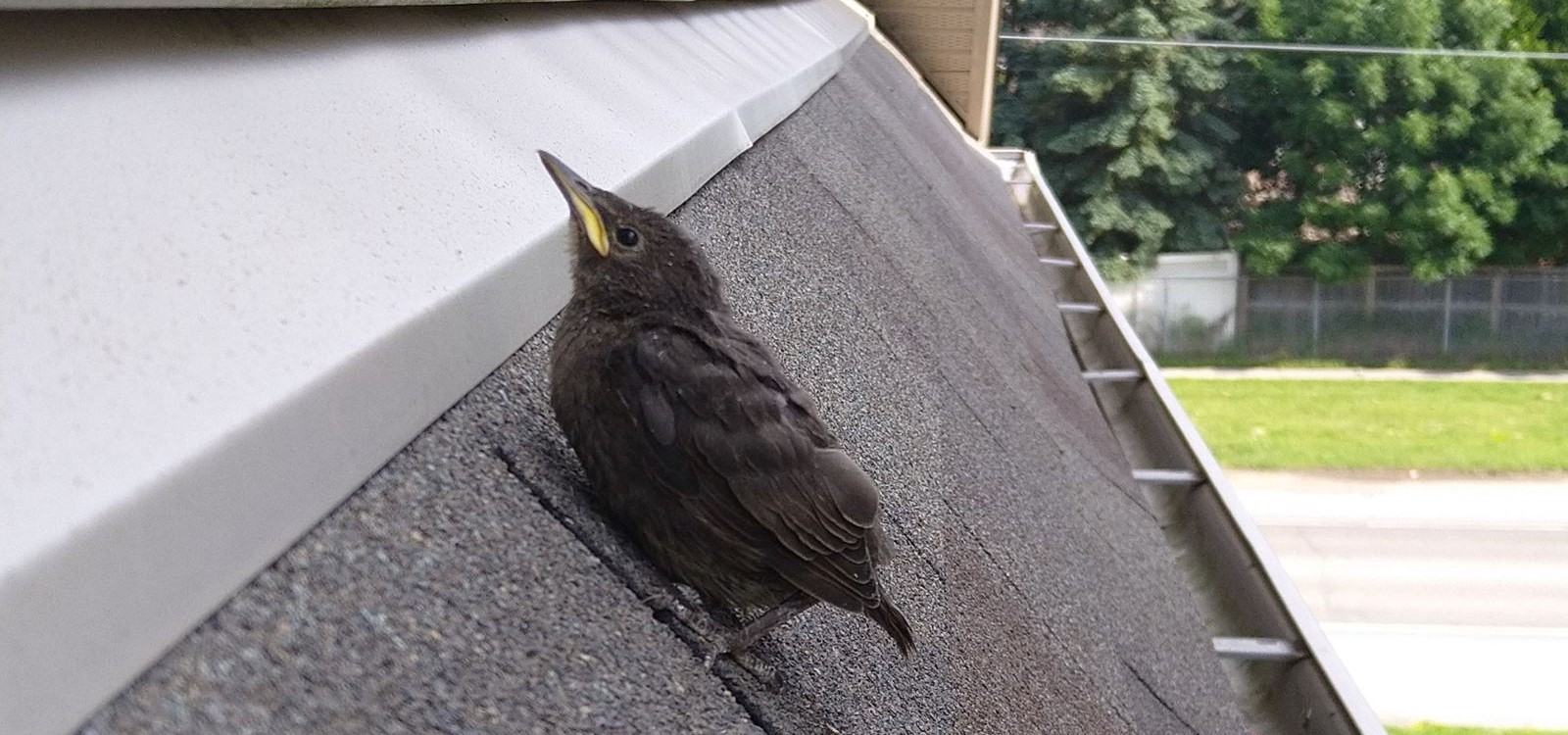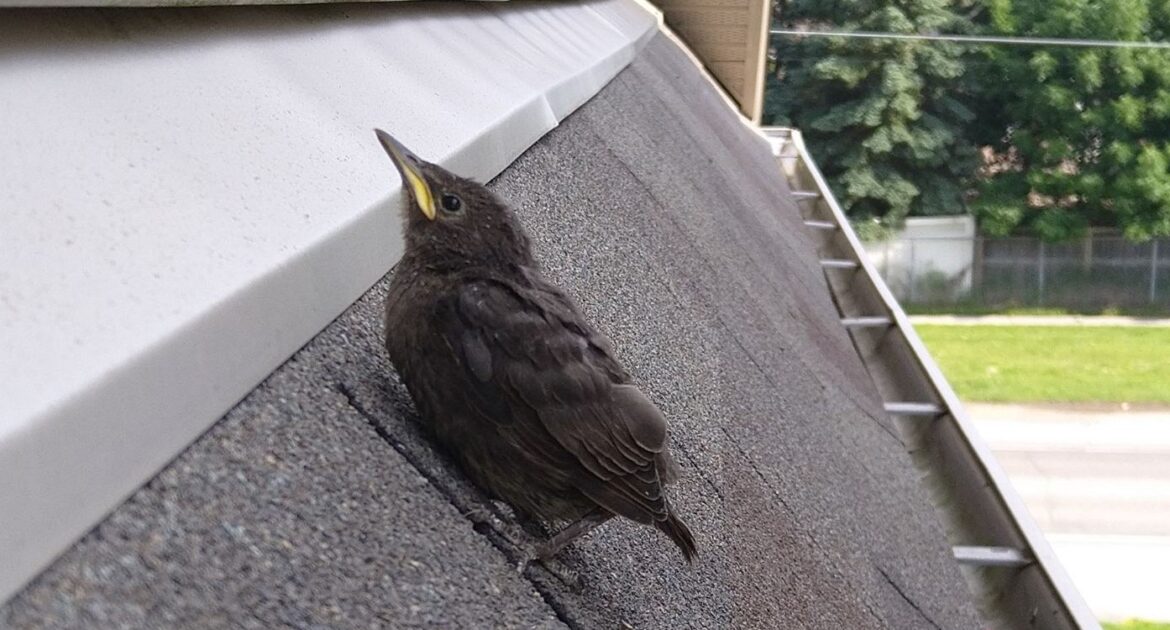Birds are a common sight around Toronto, from the iconic pigeons soaring around the CN Tower to the various songbirds that fill the Toronto Islands with melody. However, when these birds decide to make your home their own, bird watching becomes far less enjoyable. Birds nesting in homes is a frequent concern for property owners across the city, as these visitors can cause structural damage, create health hazards, and lead to costly repairs when they settle into rooflines, vents, attics, and other cozy nooks.
At Skedaddle Humane Wildlife Control, we’ve spent over three decades helping homeowners address bird infestations humanely and effectively. Our experience has given us unique insight into the most common avian tenants you might encounter and how to manage them safely. Let’s explore the different types of birds that frequently nest in homes and what you should know about each species.
Common Toronto Nesting Birds and Their Preferred Locations
Understanding which birds are likely to set up house in your property helps in identifying and addressing potential problems early. Here are the most frequent visitors to Toronto homes:
European Starlings
Starlings are perhaps the most problematic birds when it comes to nesting. These birds are often most drawn to:
- Bathroom and kitchen exhaust vents
- Dryer vents
- Soffit openings
- Damaged roof areas
Identifying features: Dark feathers with an iridescent sheen and speckled appearance, pointed beaks, and a fairly robust body.
Nesting behaviour: Starlings stuff their nesting sites with dry materials like twigs, grass, and leaves. This creates a serious fire hazard, especially in vents connected to appliances that generate heat. Their nests can completely block ventilation systems, causing moisture buildup and potential mold issues in your home.
House Sparrows
Despite their small size, house sparrows can cause significant issues when they nest in urban homes:
- Dryer and exhaust vents
- Gaps in siding
- Spaces behind shutters
- Light fixtures and porch ceilings
Identifying features: Small birds with males showing grey caps and chestnut markings on their wings, while females are more uniformly brown.
Nesting behaviour: Sparrows are prolific breeders, often producing multiple broods each season. They build messy nests with feathers, grass, and debris. Their persistent behaviour means they’ll return to the same nesting sites year after year unless preventive measures are taken.
Rock Pigeons
The urban landscape provides a perfect habitat for pigeons, which naturally nest on cliff faces but have adapted to use buildings as substitutes:
- Flat rooftops
- Air conditioning units
- Ledges and window sills
- Roof eaves and gutters
Identifying features: Grey bodies with iridescent neck feathers, short legs, and distinctive cooing calls.
Nesting behaviour: Pigeons have a unique ability to breed year-round in urban environments, unlike most bird species that stick to spring and summer nesting. Their droppings are highly acidic and can damage building materials like brick, metal, and concrete when left untreated.
Health and Property Risks Associated with Bird Nesting
When birds take up residence in homes, they bring more than just noise. Here are the primary concerns homeowners should be aware of:
Health Hazards
- Respiratory Diseases: Bird droppings can harbour fungal spores that cause histoplasmosis and psittacosis, which affect the respiratory system when particles become airborne and are inhaled.
- Bacterial Infections: Salmonellosis can be transmitted through contact with surfaces contaminated by bird droppings.
- Parasites: Birds often carry mites, ticks, and fleas that can infest homes and bite humans.
Safe handling of bird droppings is essential. Our Skedaddle technicians use specialized gear to safely remove contaminated materials without spreading pathogens throughout your home.
Property Damage
Birds can cause several types of damage to homes:
- Fire hazards from nesting materials blocking vents
- Ventilation obstruction leading to poor indoor air quality
- Structural damage to roofing materials
- Permanent staining from acidic droppings on exterior surfaces
- Clogged gutters causing water damage
Understanding Bird Behaviour Throughout the Seasons
Birds’ nesting patterns in homes follow seasonal cycles that influence when and how they should be managed:
Spring and Summer Nesting
Most bird species begin nesting activities in early spring, with peak activity occurring from April through July. During this time:
- Females lay eggs that typically hatch within 10-30 days
- Nestlings remain dependent on parents for several weeks
- Both parents actively feed and protect their young
Important consideration: The first three weeks of life are critical for most bird chicks, as they’re unable to fly and completely dependent on parental care. Any removal during this time must account for keeping families together.
Fall and Winter Patterns
While most birds complete their nesting cycle by late summer, some adaptable species like pigeons may continue breeding through fall and even winter if:
- Food sources remain plentiful
- Sheltered nesting locations provide protection from elements
- Urban heat islands (like downtown) create milder microclimates
Bird Control Toronto: Professional vs. DIY Approaches
When facing birds nesting in homes, homeowners often wonder about the best approach.
Why Professional Bird Removal Works Better
- Species-specific strategies: Different birds require different removal techniques based on their behaviour and nesting preferences.
- Legal compliance: Many bird species are protected under the Migratory Bird Act, requiring specific handling protocols. Our technicians know which species (house sparrows, European starlings, and pigeons) aren’t protected and can be removed, while ensuring all other species are handled according to regulations.
- Proper equipment: Accessing nesting sites often requires roof and ladder safety training that our technicians receive, allowing them to reach high areas safely.
- Complete removal: Effective bird control requires not just removing the birds but also all nesting materials and properly cleaning contaminated areas.
Common DIY Deterrents and Their Limitations
- Decoy owls: Birds quickly learn these aren’t real threats and return to nesting sites.
- Bird spikes: While sometimes effective for ledges, they don’t address entry points into vents and soffits.
- Visual deterrents: Reflective objects may provide temporary relief but rarely offer long-term solutions.
Skedaddle’s Humane Bird Control Process for Toronto Homes
Our three-decade experience has helped us develop a comprehensive approach to birds nesting in Toronto homes:
Assessment and Removal
Our wildlife technicians begin by:
- Identifying all bird entry points around your home
- Determining the species involved and its breeding cycle stage
- Developing a customized removal strategy that keeps bird families together
- Safely accessing high areas using certified ladder and roof safety techniques
For situations involving baby birds, we utilize specialized approaches:
For flying birds: We ensure adults and juveniles can exit but not re-enter.
For non-flying babies: In some cases, like with starlings nesting in vents, we can carefully hand-remove babies and place them in a temporary nest container. This allows parent birds to continue caring for their young until they can fly.
Cleaning and Sanitization
After bird removal, thorough cleaning is essential:
- Complete removal of all nesting materials
- Sanitization of affected areas to eliminate health risks
- Cleaning of droppings from exterior surfaces to prevent damage
- Inspection of ventilation systems for potential blockages
Prevention and Protection
The final step involves protecting your home from future bird infestations. We assess and seal potential entry points with durable materials that deter birds long-term, reducing the likelihood of future issues. Implementing deterrents such as anti-bird spiking on frequently used ledges enhances security against nesting.
Ensuring a bird-free home environment requires both an understanding of the specific challenges birds present as well as adopting humane, effective control measures. Skedaddle Humane Wildlife Control is ready to partner with you in safeguarding your property. If bird nesting is a concern, contact Skedaddle today for expert consultation and a comprehensive solution tailored to your needs. Protect your home, health, and peace of mind with our proven services.




